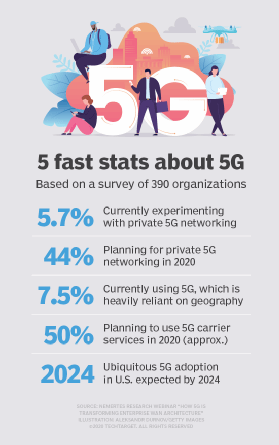
kentoh - Fotolia
WAN transformation sparked by 5G, cloud and SD-WAN technologies
In a modern world, legacy WAN architecture is rife with shortcomings. But 5G features and use cases could help jump-start a WAN transformation for many organizations.
In the old days, about a decade ago, remote employees would go into a branch office, sit at a desk with a laptop or desktop computer and connect to the company LAN, which connected to the company WAN, which, in turn, connected to the company data center. In those days, when network architects built a WAN, the goal was to couple inside employees to inside network resources, essentially linking employees on company property to resources on company property.
That setup is mostly gone. Today, many companies serve both inside employees and outside partners on their WANs. In fact, 60% of WANs are now serving outside customers, contractors and suppliers, according to a recent study of 390 organizations by Nemertes Research, an advisory and consulting firm based in Mokena, Ill.
Most workloads no longer reside inside the data center, Nemertes CEO Johna Till Johnson said in a recent webinar. The notion of connecting users to inside the data center has vanished. Increasingly, users are somewhere else. Maybe they're on another WAN or the internet. Essentially, company WANs are now connecting outside users to outside cloud resources.
The WAN as a connectivity medium for outsiders is a concept that emerged just last year, Johnson said. And that shift from inside-to-inside to outside-to-outside communications dovetails almost perfectly with the advent of 5G, the next generation of cellular technology.
Enter 5G, of course

About 60% of organizations plan to use 5G carrier services by the end of 2021, according to Nemertes, even as enterprises assess 5G. Additionally, 55% of organizations plan to use 5G private networking services by the end of 2021.
The introduction of 5G could address some WAN disadvantages. The use of cellular connectivity could, for example, eliminate the need for MPLS links and their associated high fixed costs. Enterprises that move their physical branch offices could more quickly deploy a 5G-based WAN without having to worry about rearchitecting their entire WAN. Finally, replacing wired WANs with cellular WANS would help enterprises significantly cut down the time needed to put a WAN into operation.
Additionally, WAN architecture could benefit from the following 5G features:
- gigabit-speed bandwidth that could serve as an alternate WAN connectivity option;
- low latency that works well for sensitive applications, such as IoT and multimedia;
- enterprise-friendly carrier pricing that competes with wired services; and
- embedded security at the physical layer.
Five enterprise use cases for 5G WAN architecture
As 5G and WAN architecture could coalesce, some key use cases start to emerge for businesses, including the following:
- Instant-on WAN in a box. The emergence of 5G can change how network professionals think about the WAN by moving to an instant-on mindset. For example, if a global company is opening a branch office in some part of the world, instead of digging up roads to get access to wired connectivity, the company could deploy "WAN in a box," Johnson said. The company can deploy a wireless device to use 5G for the initial and instant turnup with higher bandwidth and lower latency than the wired connection, which could be added later, if necessary.
- Failover and backup. Organizations could use 5G for redundancy and backup to improve the performance of branch offices. Well-established branch offices might have a single connection or a dual connection with fiber in the same circuit. So, a single disruption could take out both carriers' fiber connection to the office. Some industries could not tolerate that kind of disruption. So, they need something that's physically redundant, and 5G can help.
- Bursting and overflow. Similarly, 5G bursting and overflow provide redundancy, backup and incremental bandwidth at branch offices. If organizations have wired and wireless connections to the same office, they'd mostly use the wired connection. The wireless connection could handle bursting and overflow traffic and not serve purely as backup. Software-defined WAN is an important element here as it enables enterprises to mix and match 5G and wireline technologies for optimal performance. Wired versus wireless pricing is a key consideration in this use case.
- Wireless is the WAN. As an extension of the first use case, organizations could use gigabit wireless for sole connectivity of branch offices to the cloud, private data center or both. In this use case, the WAN goes the way of the LAN. Long ago, all LANs were wired, but then Wi-Fi changed the LAN game, Johnson said. Nemertes anticipates wireless and 5G to have a similar effect on the WAN.
- Private networking. In this final use case, 5G is seen as the campus network, factory floor network and Wi-Fi replacement. Why would organizations want to replace Wi-Fi? Because, once it becomes highly scaled with lots of users and no real control over those users, the Wi-Fi network can become a nightmare to manage, Johnson said.
But do enterprises really need 5G?
In sum, consider 5G WAN as part of a next-generation WAN strategy, Johnson urged. As you talk with technology decision-makers in your organization and plot your five-year plan, you'll want to consider how 5G factors into that plan and if you even need it.
"The answer might be you don't [need 5G], and that's a perfectly valid answer. But if you haven't looked at it, then that's not a valid answer," Johnson said. "You can consider it and reject it, but you need to at least consider it as part of your next-generation WAN strategy."
Instead of wasting time and energy massaging a legacy WAN, Johnson said, you should consider rearchitecting the entire system.







